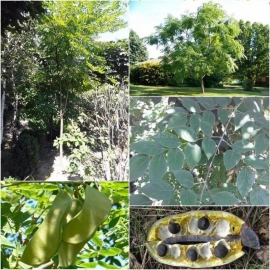






Organic Kentucky coffee tree Seeds (Gymnocladus dioicus)
3.00 €
Tree up to 30 m tall, with a slender trunk and luxurious, free standing, rounded crown reaching 8 m in diameter. Fruits are red-brown, after ripening bluish-black leathery beans up to 20 cm long.
-
Kentucky coffee tree, Cooper of a dioecious, or Bunduk canadensis, Soap tree, Gymnocladus dioicus
A tree up to 30 m tall, with a slender trunk and a luxurious, free standing, rounded crown reaching 8 m in diameter.
The bark on the trunks is light gray, deeply cracking, darker on the shoots, with dense pubescence. Remarkable double-pinnate leaves up to 1 m long, glabrous above, leathery, pinkish when blooming, light green in summer, pale yellow in autumn. Leaves unfold later than other legumes.
The plant is dioecious. The flowers are small, yellowish white, with a lemon scent. Male - in terminal panicles up to 10 cm, female - in longer terminal tassels up to 30 cm.
Fruits are red-brown, after ripening bluish-black leathery beans up to 20 cm long.
Inside, the hard shiny brown seeds are surrounded by a dark brown gummy pulp or green jelly-like liquid that can be used as a soap or shampoo.
In addition to soap benefits, Bunduk is a good honey plant. The flowers of Bunduk are small, yellowish-white and give off a pleasant lemon scent. Blooms in May-June for 7-10 days.
Seeds after roasting (poisonous when raw!) Can be used as a coffee substitute. The drink tastes like coffee with cocoa.
Growing fast. Photophilous, medium-drought-resistant, tolerates partial flooding. Average frost resistance (up to -25 ...- 35 ° C), winter-hardy. Prefers deep enough fertile fresh soil.
It is used as a beautiful, original tree in single and small-group plantings in parks and in the form of alleys.
At home, it is grown as a greenhouse plant.
In culture since 1818. It goes well with gleditsia, chestnuts, silver maple, oaks, ash, frame, etc.
All parts of the hopper are poisonous! Because of cytisine, and it decomposes only at temperatures above 260 ° C. Therefore, drying it does not remove it. For eating, the fruits are well fried. Otherwise, you can get fatal poisoning. But it can be used as a detergent - there will be no irritation.
Landing. Several variants:
1. No stratification. The seeds are large, hard, with a very dense shell, require a violation of the latter for germination, which is usually achieved by two or three scalding with boiling water or treatment with sulfuric acid. After scalding, before sowing, the seeds must be soaked in water until they swell or peck completely.
A single treatment with concentrated sulfuric acid for 10 minutes results in a higher percentage of swollen and less rotten seeds than scalding.
2. Seed germination - 95-100%. For such a result, it is necessary to scarify the seeds - damage the upper hard shell with a file and soak in water until it swells completely. Then plant in warm ground (end of April - May).
If this is not done, the hatching will last for several years and will decrease to 30-35%.
3. The experience of the dendrological nursery of the Botanical Garden of the Academy of Sciences of Moldova showed that the most effective pre-sowing treatment of Bunduk seeds is a two-month stratification at an ordinary temperature - from 0 to + 5 °. After that, the seeds are pecked together. In order to avoid rotting during stratification, it is necessary to ensure that the seeds are well mixed with the sand and do not come into contact with each other. The layer of sand with seeds should not exceed 30 cm. The sowing period is late - the end of April - May, when the soil warms up well.
